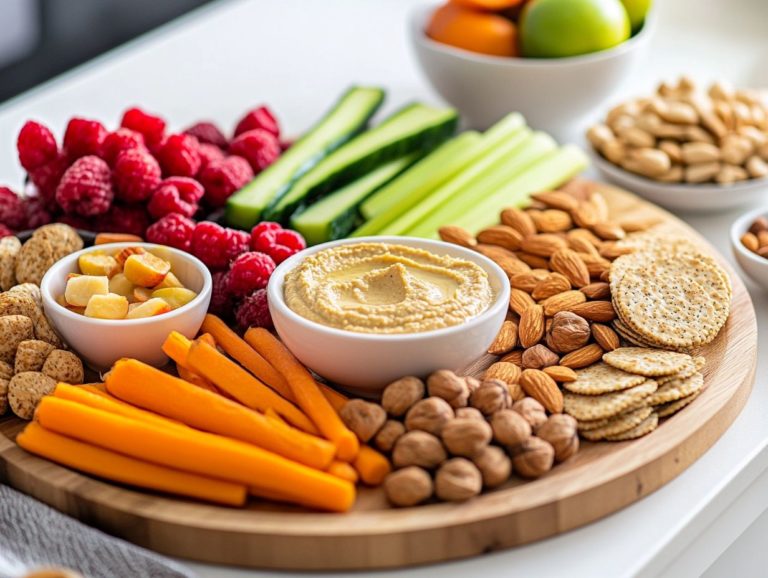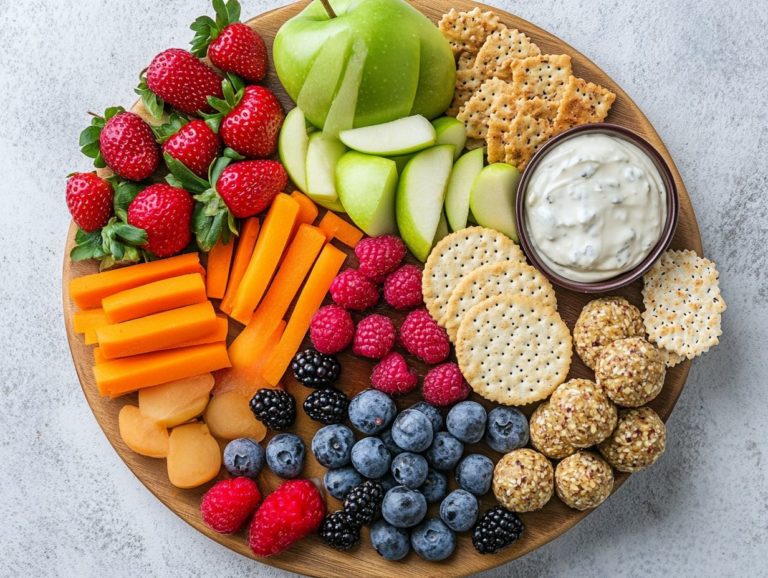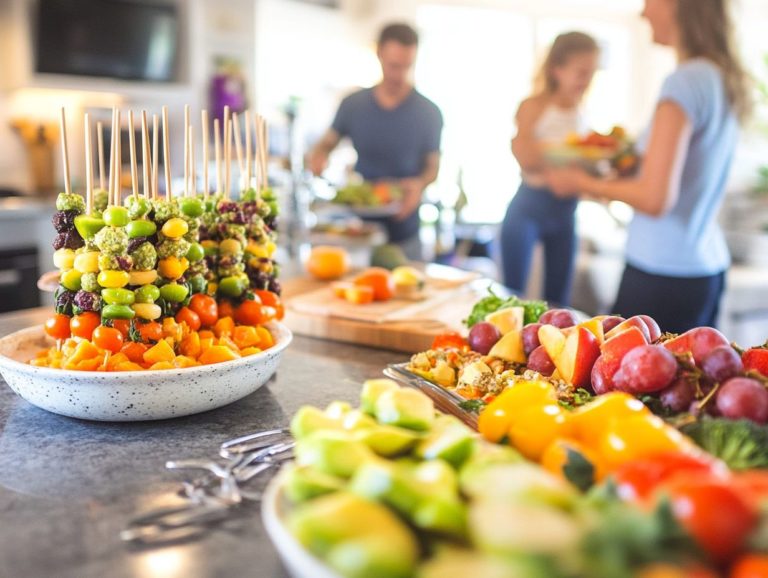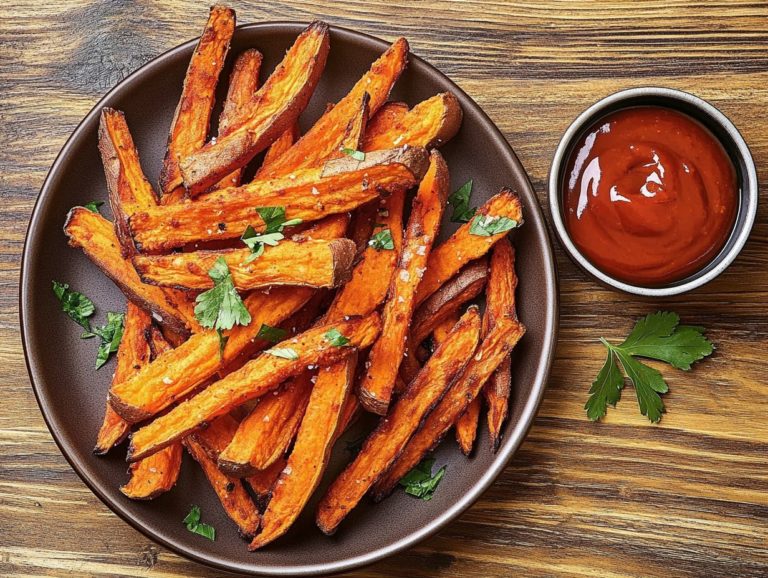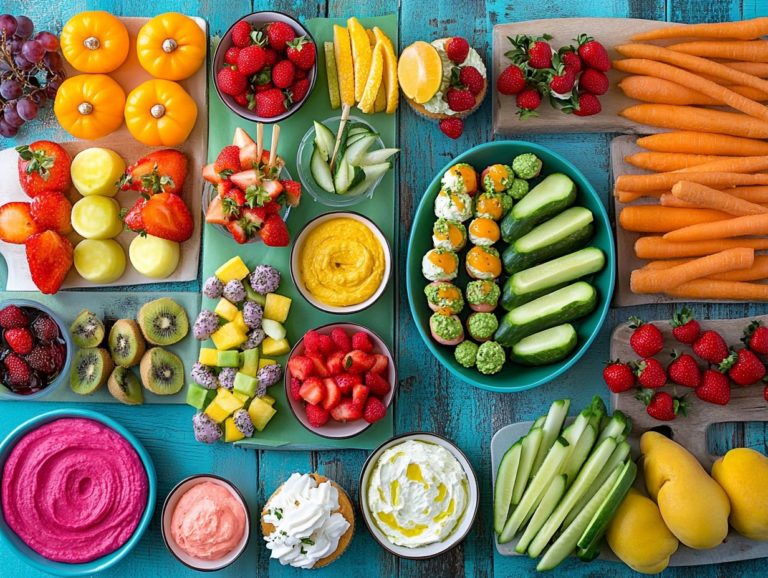How to Make Gluten-Free Chocolate Bark
Indulging in a sweet treat can be a delightful experience without compromising your dietary restrictions. Gluten-free chocolate bark emerges as a delectable and versatile option that everyone can savor. From holiday gifts to festive treats, this chocolate bark is sure to please.
This guide will reveal the essential ingredients, featuring luscious dark chocolate, versatile coconut oil, and nutritious nuts, and will walk you through a straightforward step-by-step process to create your own exquisite bark at home.
You ll uncover enticing variations and learn the best practices for storing your creations to maintain their freshness, such as utilizing refrigerator storage. Get ready to indulge your sweet tooth like never before!
Contents
- Key Takeaways:
- What Are the Ingredients for Gluten-Free Chocolate Bark?
- 3. Nuts and Dried Fruits
- How to Make Gluten-Free Chocolate Bark?
- 1. Melt the Dark Chocolate and Coconut Oil
- 2. Spread the Mixture on a Baking Sheet
- What Are Some Variations of Gluten-Free Chocolate Bark?
- What Are the Benefits of Eating Gluten-Free Chocolate Bark?
- How to Store Gluten-Free Chocolate Bark?
- 1. In an Airtight Container in the Refrigerator
- 2. In the Freezer for Longer Storage
- Frequently Asked Questions
- How do I melt the chocolate for gluten-free chocolate bark?
- Can I use any type of chocolate for gluten-free chocolate bark?
- How do I make sure my gluten-free chocolate bark sets properly?
- Can I store gluten-free chocolate bark for later?
Key Takeaways:
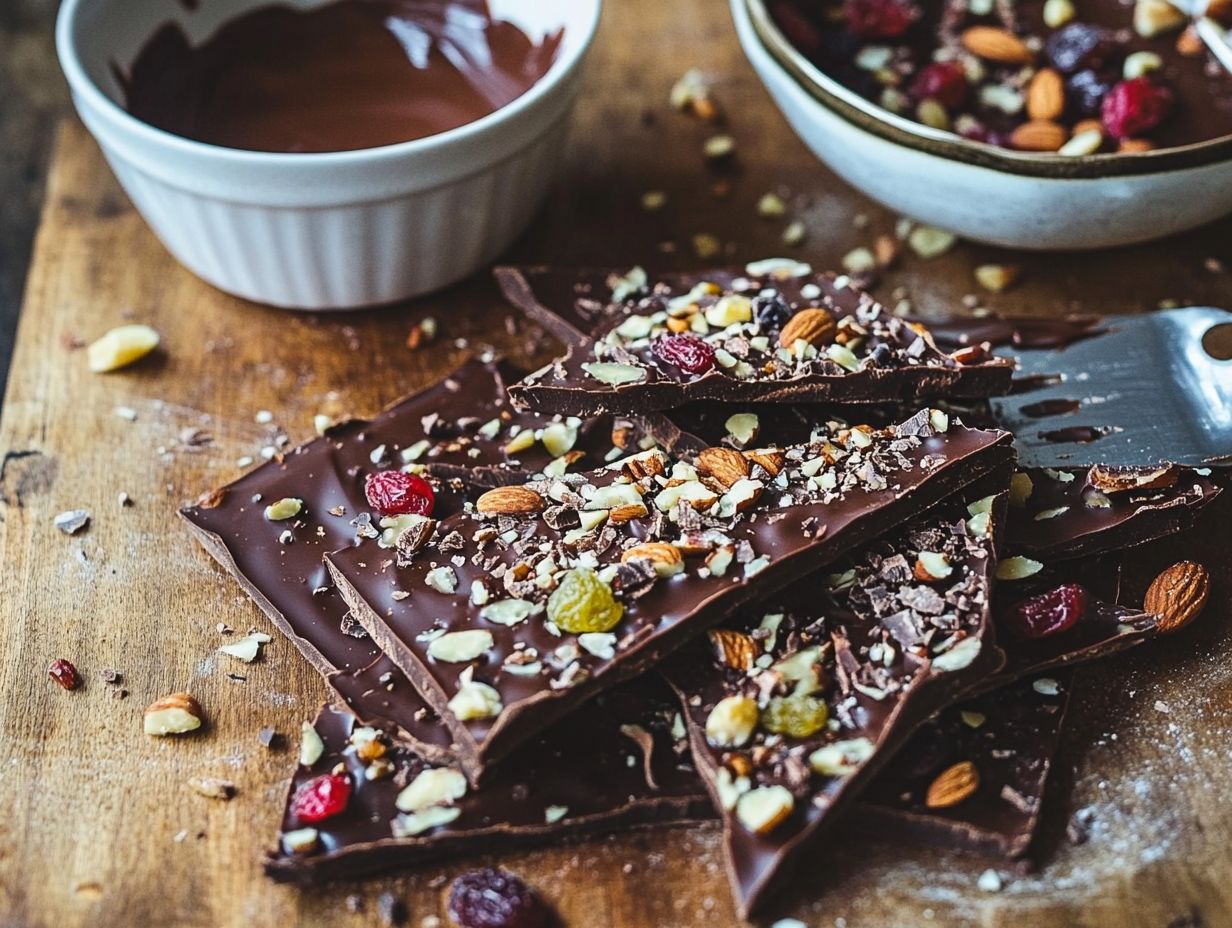
- Use dark chocolate, coconut oil, and a variety of nuts and dried fruits, including cranberries and pomegranate seeds, to make delicious and gluten-free chocolate bark.
- Melt the chocolate and coconut oil together, spread it on a baking sheet, and add toppings like chopped nuts. Let it cool and harden.
- Try variations like white chocolate with cranberries and pistachios, or pretzel bark for a sweet and salty twist. Store in an airtight container in the fridge or freezer for longer storage.
What Are the Ingredients for Gluten-Free Chocolate Bark?
Gluten-free chocolate bark is a delightful and indulgent treat that you can effortlessly whip up at home, blending an array of flavors and textures to craft a unique festive dessert.
Picture this: using high-quality dark chocolate from esteemed chocolatiers like Bernard Callebaut or Soma Chocolates, you re creating something truly special.
The beauty of this treat lies in its versatility; you can customize it with a variety of toppings, from crunchy nuts and seeds to sweet dried fruits. Incorporate pantry staples like Cheerios cereal or even plantain chips for a unique spin.
It s the perfect option for holiday gifts, catering to those with gluten and dairy sensitivities while still delivering a rich and creamy texture that everyone will relish during the Christmas season.
1. Dark Chocolate
Dark chocolate stands as a cornerstone of gluten-free chocolate bark, celebrated for its rich flavor and impressive health benefits, making it a top choice for discerning chocolate lovers. This premium ingredient enhances the sweetness of various toppings and delivers a decadently indulgent experience.
Rich in antioxidants, dark chocolate helps combat oxidative stress and supports heart health. Its lower sugar content compared to milk chocolate makes it a more mindful choice for satisfying your sweet cravings without the accompanying guilt. You can also use candy wafers for different chocolate recipes.
When crafting your own homemade chocolate bark, choosing high-quality dark chocolate amplifies these health benefits, elevating both the taste and texture of your creation. By selecting carefully sourced chocolates, you can treat yourself to a snack that is not only delicious but also nourishing, tantalizing your taste buds while supporting your overall wellness.
2. Coconut Oil
Coconut oil is absolutely essential in crafting gluten-free chocolate bark, taking center stage in the chocolate melting process and imparting a creamy texture that elevates your dessert to new heights. By incorporating coconut oil, you enhance the mouthfeel of the melted chocolate while ensuring it sets perfectly, thanks to its unique properties that cater to those with food allergies like gluten or dairy sensitivities.
This versatile oil acts as a binding agent, allowing the chocolate ingredients to blend seamlessly a key factor in achieving that luscious consistency every chocolate lover desires. Opting for coconut oil in your baking not only provides a healthier alternative to traditional butters or oils but also boasts a wealth of medium-chain fatty acids types of fats that are easily absorbed by the body and can provide energy quickly that foster energy and support heart health.
When you adhere to a gluten-free regimen, coconut oil amplifies flavors and enriches the healthful profile of your baked goods, making it the ideal choice for indulgences that don t compromise your dietary needs.
3. Nuts and Dried Fruits
Nuts and dried fruits are essential elements in gluten-free chocolate bark. They infuse both texture and flavor into this delightful treat. Options like pomegranate seeds, cranberries, almonds, walnuts, and cashews not only enhance the rich, indulgent flavor of the chocolate but also boost its nutritional profile. This makes this sweet creation a more health-conscious choice for holiday gatherings and gift-giving.
Consider almonds. They offer a satisfying crunch and heart-healthy fats. Cranberries bring a chewy tartness rich in antioxidants. Walnuts provide a luxurious, buttery taste that complements the chocolate beautifully. Cashews introduce a creamy texture that rounds out the experience. Hazelnuts and pistachios also add unique flavors to your chocolate bark.
Experimenting with different combinations can craft a delightful sweet and salty sensation. A sprinkle of sea salt can elevate the flavors even further. For a unique twist, adding plantain chips can bring an exciting texture.
For those craving extra crunch, adding Cheerios to the mix transforms each bite into an adventure for the palate. The versatility of nuts and dried fruits opens up a world of creative possibilities. You can tailor your chocolate bark to perfection.
How to Make Gluten-Free Chocolate Bark?
Creating gluten-free chocolate bark is an exciting and rewarding experience! It enables you to whip up your own homemade candy with remarkable ease, making it ideal for holiday baking or as a charming indulgence during the Christmas season.
The process is straightforward: simply melt high-quality chocolate, such as those from Bernard Callebaut or Soma Chocolates, spread it on a baking sheet, and then adorn it with your preferred toppings.
After allowing it to cool and harden, you ll have a festive treat. This not only satisfies the sweet tooth but also serves as a fun and creative activity for holiday parties, gift giving, or family gatherings.
1. Melt the Dark Chocolate and Coconut Oil
To start crafting your gluten-free chocolate bark, the first step is to melt together dark chocolate and coconut oil. This combination creates a smooth and creamy chocolate coating that beautifully holds all your chosen toppings.
The most effective way to achieve that perfect melting consistency is by using a double boiler. This method allows you to control the heat without the risk of burning the chocolate. It s essential in chocolate recipes to ensure a smooth texture.
This method involves placing a heatproof bowl over a pot of simmering water. This provides gentle, even heat that s ideal for melting. It s important to keep the temperature below 120 F; otherwise, you risk seizing the chocolate if it overheats.
As the mixture melts, stirring it ensures even liquefaction and prevents any unsightly lumps, resulting in a silky-smooth texture. By carefully monitoring the melting process, you can create a delightful base that will complement any toppings you decide to add later.
2. Spread the Mixture on a Baking Sheet
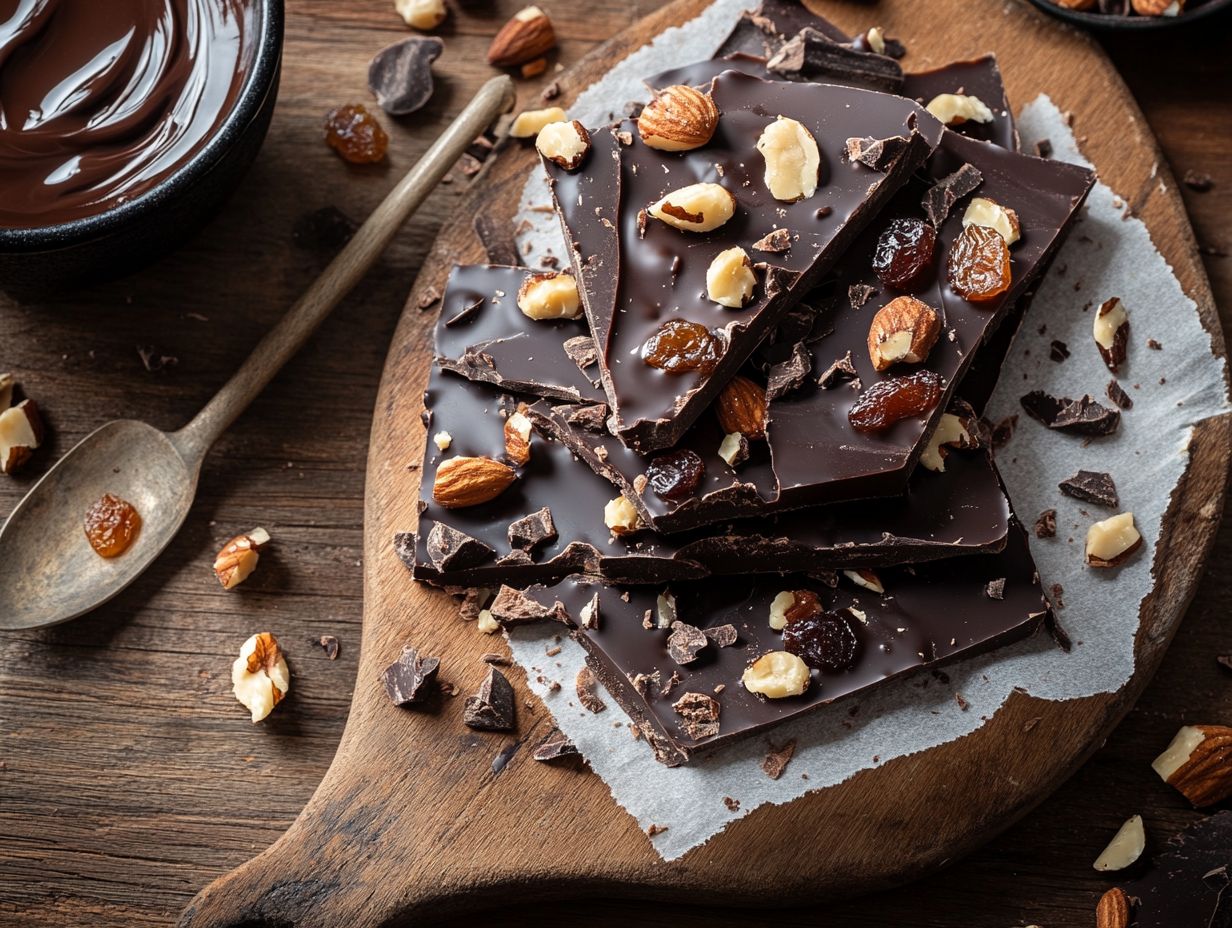
Once you ve melted the dark chocolate and coconut oil to perfection, the next step is to spread this delightful mixture evenly onto a baking sheet. This forms a solid base for your gluten-free chocolate bark. This step is essential for ensuring that the bark hardens uniformly, making it easy to break into pieces later.
To achieve that perfectly smooth and even layer, it s best to use a spatula or an offset knife. Gently glide it across the surface to distribute the chocolate evenly. Tilt the baking sheet slightly to allow the chocolate to flow into the corners, ensuring every inch is beautifully covered. Such presentation ideas ensure that your easy recipe looks professional and appetizing.
Using parchment paper or silicone mats is a game-changer. These prevent sticking and simplify the cleanup process, allowing for a hassle-free release of your finished bark. These techniques not only enhance the overall presentation but also elevate the enjoyment of your final treat, making all the effort truly worthwhile.
Try this recipe yourself and share your variations or experiences with others!
3. Add Nuts and Dried Fruits
Once you spread the melted chocolate on the baking sheet, it s your moment to shine. Get creative and try adding your favorite nuts, seeds, and dried fruits for a stunning and delicious combination.
Consider toppings like pomegranate seeds, cranberries, or even Cheerios for an unexpected twist. These choices not only add texture but also boost the nutritional value of your bark.
Add almonds and walnuts for a satisfying crunch with heart-healthy fats. Pumpkin seeds provide delightful texture and a boost of zinc.
For flavor experimentation, pair the rich chocolate with a sprinkle of sea salt to accentuate the sweetness. A hint of chili powder can add a delightful kick for spice lovers.
The true beauty of crafting this indulgent treat lies in its versatility. Mix and match these delightful options to create a personalized chocolate bark experience that reflects your unique taste.
Whether you crave the indulgent flavor of pretzel bark or the nutty richness of chopped nuts, the possibilities are endless!
4. Let It Cool and Harden
The final step is to let your gluten-free chocolate bark cool and harden. Don t wait! Place your baking sheet in the refrigerator now for quicker results.
This crucial phase ensures the chocolate sets properly, achieving a firm, snap-worthy texture characteristic of high-quality homemade treats.
For the best results, chill the chocolate for at least 30 minutes. If you have time, letting it sit at room temperature for a couple of hours can enhance its flavor.
Once the chocolate has solidified and lost its shine, you ll know it s ready. Your gluten-free treat will be perfect for holiday parties or gift-giving occasions.
To break the chocolate into uniform pieces, use a sharp knife or apply gentle pressure by hand for a charming rustic look. The pieces will fit beautifully in gift boxes, making them perfect for sharing.
What Are Some Variations of Gluten-Free Chocolate Bark?
Exploring different variations of gluten-free chocolate bark allows you to cater to diverse tastes. Whether using dried fruit or new toppings, there’s something for everyone!
Imagine white chocolate with tart cranberries and crunchy pistachios, or rich milk chocolate topped with roasted almonds and a hint of sea salt. Each variation offers unique flavors, perfect for elevating your holiday gifting.
1. White Chocolate Bark with Cranberries and Pistachios
White chocolate bark adorned with cranberries and pistachios is a stunning twist that marries the creamy sweetness of white chocolate with the tartness of dried cranberries and the delightful crunch of pistachios. This exquisite treat makes for an appealing holiday gift that is sure to impress.
Offering a colorful contrast to traditional chocolate bark, this gluten-free recipe delivers an indulgent flavor that will wow your family and friends. You can even create variations like pretzel bark for a unique spin.
To craft this delightful creation, begin by melting 12 ounces of high-quality white chocolate using a double boiler or microwave, stirring until it reaches a smooth consistency. This method ensures the chocolate melting process goes smoothly. Once melted, pour the chocolate onto a lined baking sheet, spreading it to a thickness of about a quarter inch.
Next, generously sprinkle 1 cup of dried cranberries and 1 cup of chopped pistachios over the surface, gently pressing them into the white chocolate to ensure they adhere. Allow the bark to cool at room temperature until it sets, then break it into irresistible pieces for serving.
The tartness of the cranberries perfectly balances the rich sweetness of the chocolate, while the pistachios provide a satisfying crunch that elevates each bite, making this treat not only delicious but also visually striking.
2. Milk Chocolate Bark with Almonds and Sea Salt
Milk chocolate bark with almonds and sea salt presents you with a delightful fusion of sweet and salty flavors, crafting an irresistible treat that is simply perfect for holiday gift-giving. The creamy texture of high-quality milk chocolate harmonizes beautifully with sliced almonds and a sprinkle of sea salt, elevating the overall taste and adding a gourmet flair.
To embark on this delicious journey, begin by melting your premium milk chocolate in a microwave-safe bowl. Remember to pause and stir occasionally to achieve that smooth consistency you desire. This process ensures a perfect chocolate coating. Once melted, fold in roasted almond slices these provide a crucial crunch that contrasts exquisitely with the velvety chocolate. Next, spread the mixture onto a parchment-lined baking sheet, ensuring an even layer for uniform texture.
Just before it sets, sprinkle a pinch of coarse sea salt on top; this step is essential as it enhances the chocolate’s sweetness while delivering that savory bite you crave. After it cools, break the bark into irregular pieces for an artisanal touch, and savor the perfect balance of flavors with every delightful morsel.
3. Vegan Chocolate Bark with Coconut Flakes and Pumpkin Seeds
Vegan chocolate bark with coconut flakes and pumpkin seeds is an exceptional choice for those who appreciate dairy-free delights, offering a refreshing twist on the classic chocolate bark. This gluten-free and plant-based recipe marries the rich taste of vegan chocolate with the satisfying crunch of pumpkin seeds and the sweetness of coconut flakes, delivering a delightful medley of textures and flavors. The use of pantry staples like coconut flakes and pumpkin seeds makes this an easy recipe to whip up anytime.
Not only does this indulgent treat quell your chocolate cravings, but it also demonstrates the remarkable versatility of plant-based ingredients, appealing to both vegans and non-vegans alike. When selecting vegan chocolate, make it a point to choose brands that clearly label their products as dairy-free and gluten-free, ensuring you can indulge without any worries.
The addition of pumpkin seeds, brimming with magnesium, antioxidants, and healthy fats, significantly enhances the nutritional value, promoting heart health and providing a much-needed energy boost. Meanwhile, coconut flakes add fiber and healthy medium-chain triglycerides, making each mouthful not just delicious but also nourishing.
Whether you savor it as a quick snack or a delightful dessert, this vibrant bark stands out as an excellent choice for health-conscious individuals eager to indulge without guilt.
What Are the Benefits of Eating Gluten-Free Chocolate Bark?

Indulging in gluten-free chocolate bark offers a wealth of benefits, making it an exquisite choice for those with dietary restrictions, including individuals with celiac disease or gluten intolerance. Utilizing simple recipe techniques and high-quality ingredients can significantly enhance the final product.
This delectable treat not only satisfies your sweet cravings but also delivers a delightful blend of healthy fats from nuts and antioxidants from dark chocolate.
It shows that dessert can be both indulgent and nourishing, allowing you to enjoy a guilt-free experience.
1. Gluten-Free Option for Those with Celiac Disease or Gluten Intolerance
For those navigating the challenges of celiac disease or gluten intolerance, gluten-free chocolate bark offers a safe and delicious indulgence. It lets you savor the moment without the worry of food allergies. This gluten-free delight ensures that you can enjoy treats like chocolate bark, which can be elusive in traditional baked goods.
As awareness of gluten sensitivities continues to rise, the demand for alternatives that don t skimp on flavor or texture is booming. Homemade chocolate bark emerges as a versatile option, allowing you to experiment with a variety of ingredients such as nuts, seeds, and dried fruits all while steering clear of gluten entirely.
This flexibility satisfies your sweet tooth while catering to dietary restrictions. It makes for an ideal treat for gatherings or your own enjoyment. With the power to select high-quality ingredients, homemade chocolate bark remains a delightful indulgence that everyone can relish, regardless of dietary limitations.
2. Rich in Antioxidants from Dark Chocolate
Dark chocolate is not just a delightful addition to your gluten-free chocolate bark; it s also a powerhouse of antioxidants that come with a myriad of health benefits. Incorporating high-cocoa chocolate into your balanced diet can help you combat cell damage from free radicals and enhance your overall well-being, all while satisfying that sweet tooth.
Rich in flavonoids, especially catechins and epicatechins, dark chocolate supports heart health by improving blood flow and lowering blood pressure. These potent antioxidants work to reduce inflammation and may even boost your cholesterol profile by increasing HDL (the good kind) while decreasing LDL (the not-so-good kind).
Indulging in dark chocolate can enhance brain function, showcasing its potential as a true ally in health promotion. When consumed in moderation, chocolate bark crafted from rich cocoa becomes a guilt-free treat, enabling you to enjoy these incredible benefits while savoring something truly delightful.
3. Provides Healthy Fats and Protein from Nuts and Dried Fruits
Incorporating nuts and dried fruits into your gluten-free chocolate bark not only elevates the flavor but also infuses your treat with essential nutrients, including healthy fats and protein. By adding ingredients such as almonds, walnuts, and pumpkin seeds, this delightful confection evolves into a more balanced option that aligns beautifully with a nutritious diet.
These additions create a wonderful contrast in both texture and taste, delivering a robust array of vitamins and minerals. For instance, almonds are brimming with vitamin E, an antioxidant that supports skin health, while walnuts are rich in omega-3 fatty acids, which are known to be beneficial for heart health.
Dried fruits like cranberries and apricots introduce a natural sweetness along with dietary fiber, promoting digestive health and helping you feel full longer. Also, consider incorporating Cheerios cereal or plantain chips for a unique spin.
Collectively, these components transform chocolate bark into a satisfying indulgence a guilt-free snack that nourishes your body and suits any health-conscious lifestyle.
Try making your own chocolate bark today and enjoy the delicious benefits!
How to Store Gluten-Free Chocolate Bark?
Proper storage is key to maintaining the delicious flavor and texture of your gluten-free chocolate bark. Follow the cooking instructions and store your chocolate in an airtight container. For extended freshness, consider refrigerator storage, especially during warmer months.
Storing gluten-free chocolate bark properly is crucial for preserving its freshness and exquisite texture. This allows you to enjoy this delightful treat for days, even weeks. It’s perfect for surprising your loved ones during the holidays!
By placing the bark in an airtight container and storing it in the refrigerator, you can extend its shelf life while protecting it from moisture and other contaminants. This simple step ensures that each bite remains as delicious as the first. It’s particularly effective during holiday baking.
1. In an Airtight Container in the Refrigerator
Storing gluten-free chocolate bark in an airtight container in the refrigerator is one of the best ways to preserve its freshness and prevent it from absorbing unwanted odors. This method keeps the chocolate firm and retains its delightful flavor for an extended period. Use this method for homemade candy and holiday gifts.
Maintain a steady temperature in your fridge, ideally between 32 F and 40 F, to avoid fluctuations that could cause the chocolate to bloom or develop a chalky appearance. An airtight container effectively prevents moisture from seeping in, which can lead to spoilage or undesirable texture changes. This is especially important when making sweet and salty treats like pretzel bark or candy wafers.
When stored properly, your chocolate bark can last up to two to three weeks in the refrigerator while still tasting fresh. You can indulge in enjoyable snacking over time without sacrificing quality, making it an ideal dessert recipe for holiday parties and gift giving.
2. In the Freezer for Longer Storage
If you’re looking to keep gluten-free chocolate bark for an extended period, storing it in the freezer is an excellent choice that preserves both taste and texture. When properly wrapped and placed in an airtight container, chocolate bark can remain in the freezer for several months without compromising its quality and flavor. Consider adding plantain chips or pumpkin seeds for a unique spin on this festive treat.
To prevent freezer burn or unwanted moisture, tightly wrap the bark in plastic wrap or aluminum foil before placing it in an airtight container. This extra layer of protection helps maintain its delicious flavor and smooth texture. Adding pomegranate seeds or nuts and seeds like hazelnuts and almonds can enhance its indulgent flavor.
When the craving strikes, simply transfer the desired pieces from the freezer to the refrigerator to allow them to defrost gradually. This method prevents the chocolate from becoming overly soft while revitalizing the flavors, ensuring that each bite is as delightful as when it was first made. It’s a great technique for gift giving and enjoying delicious gifts during the Christmas season.
Frequently Asked Questions
Here are some common questions about gluten-free chocolate bark to help you get started!
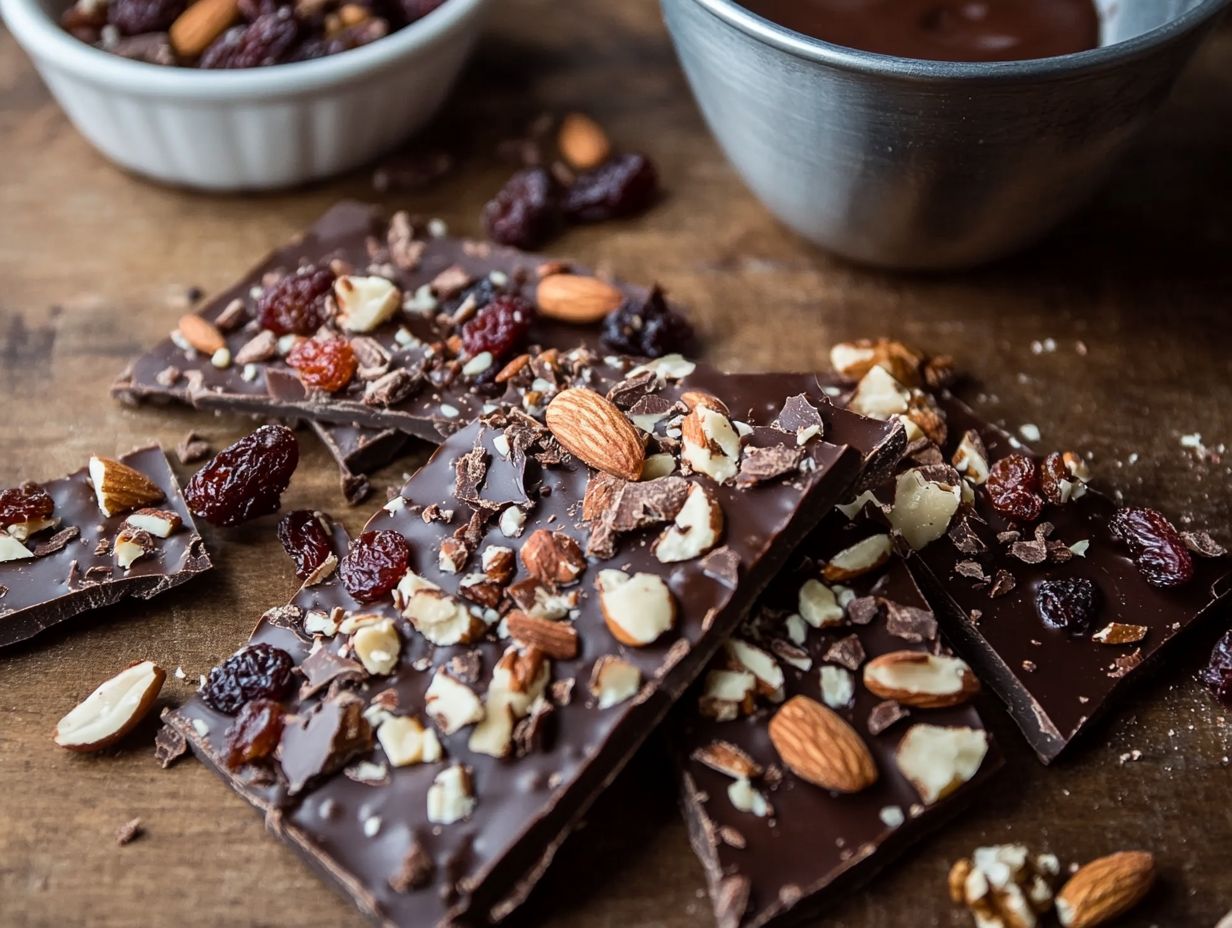
What is gluten-free chocolate bark?
Gluten-free chocolate bark is a sweet treat made with chocolate and various toppings, such as nuts, dried fruit, or candy. It is a great option for those with gluten sensitivities or allergies. Brands like Bernard Callebaut and Soma Chocolates offer excellent choices for high-quality chocolate.
What ingredients do I need to make gluten-free chocolate bark?
To make gluten-free chocolate bark, you will need gluten-free chocolate chips or bars, a variety of toppings, and parchment paper. You can also add additional flavorings, such as vanilla extract or sea salt. Try using a mix of dark chocolate, milk chocolate, and white chocolate for a rich and creamy texture.
How do I melt the chocolate for gluten-free chocolate bark?
The best way to melt chocolate for gluten-free chocolate bark is to use a pot filled with water and a heatproof bowl on top. This method ensures that the chocolate melts evenly and prevents it from burning.
You can also use a microwave, but be sure to stir the chocolate frequently to avoid burning. Follow these cooking instructions carefully for the best results.
Can I use any type of chocolate for gluten-free chocolate bark?
Absolutely! You can enjoy any chocolate type for your gluten-free bark, just check that it s gluten-free. This includes dark, milk, and white chocolate.
Be sure to check the ingredient list to ensure it does not contain any gluten-containing ingredients. Remember, using high-quality chocolate will enhance the overall indulgent flavor of your bark.
How do I make sure my gluten-free chocolate bark sets properly?
To ensure your gluten-free chocolate bark sets properly, it is important to spread the melted chocolate evenly on the parchment paper. You can also place it in the fridge for a few minutes to help it set faster.
Once it is completely hardened, you can break it into pieces and enjoy! Use a baking sheet lined with parchment paper for the best results.
Can I store gluten-free chocolate bark for later?
You ll love knowing you can store gluten-free chocolate bark in an airtight container at room temperature for up to 1 week.
Stash it in the fridge or freezer for even longer enjoyment! Just be sure to let it come to room temperature before indulging. This makes it convenient for holiday baking and holiday parties.

